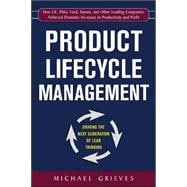
Dr. Michael Grieves founded the Product Lifecycle Management Development Consortium University of Michigan's College of Engineering and served as its Co-Director. He developed the first on-line Product Lifecycle Management Overview course for College's Center for Professional Development and organizes and chairs the annual University of Michigan AUTOe IT Conference. Grieves also is affiliated with the University of Arizona's internationally ranked MIS Department. Grieves works with PLM users and suppliers to companies such as General Electric, IBM, and Toyota on PLM strategies and implementations. With 35 years industry experience, Grieves is a principal in the international management and IT consulting firm, Core Strategies Inc and serves on the boards of a number of technology companies.
| Acknowledgments | xi | ||||
|
1 | (28) | |||
|
6 | (6) | |||
|
12 | (4) | |||
|
16 | (3) | |||
|
19 | (6) | |||
|
25 | (4) | |||
|
29 | (36) | |||
|
32 | (8) | |||
|
40 | (5) | |||
|
41 | (1) | |||
|
42 | (1) | |||
|
43 | (1) | |||
|
44 | (1) | |||
|
44 | (1) | |||
|
45 | (10) | |||
|
46 | (3) | |||
|
49 | (3) | |||
|
52 | (2) | |||
|
54 | (1) | |||
|
55 | (7) | |||
|
56 | (6) | |||
|
62 | (3) | |||
|
65 | (30) | |||
|
65 | (6) | |||
|
71 | (6) | |||
|
77 | (16) | |||
|
78 | (3) | |||
|
81 | (2) | |||
|
83 | (3) | |||
|
86 | (3) | |||
|
89 | (2) | |||
|
91 | (2) | |||
|
93 | (2) | |||
|
95 | (34) | |||
|
96 | (13) | |||
|
96 | (3) | |||
|
99 | (2) | |||
|
101 | (2) | |||
|
103 | (2) | |||
|
105 | (4) | |||
|
109 | (8) | |||
|
110 | (2) | |||
|
112 | (2) | |||
|
114 | (1) | |||
|
115 | (2) | |||
|
117 | (10) | |||
|
118 | (3) | |||
|
121 | (6) | |||
|
127 | (2) | |||
|
129 | (30) | |||
|
129 | (4) | |||
|
133 | (23) | |||
|
134 | (9) | |||
|
143 | (9) | |||
|
152 | (4) | |||
|
156 | (3) | |||
|
159 | (26) | |||
|
159 | (3) | |||
|
162 | (2) | |||
|
164 | (3) | |||
|
167 | (1) | |||
|
168 | (1) | |||
|
169 | (2) | |||
|
171 | (1) | |||
|
172 | (2) | |||
|
174 | (1) | |||
|
175 | (3) | |||
|
178 | (2) | |||
|
180 | (1) | |||
|
181 | (2) | |||
|
183 | (2) | |||
|
185 | (32) | |||
|
185 | (4) | |||
|
189 | (3) | |||
|
192 | (21) | |||
|
193 | (11) | |||
|
204 | (3) | |||
|
207 | (1) | |||
|
208 | (5) | |||
|
213 | (4) | |||
|
217 | (16) | |||
|
217 | (6) | |||
|
218 | (2) | |||
|
220 | (2) | |||
|
222 | (1) | |||
|
223 | (2) | |||
|
225 | (1) | |||
|
226 | (1) | |||
|
226 | (2) | |||
|
228 | (1) | |||
|
229 | (2) | |||
|
231 | (2) | |||
|
233 | (30) | |||
|
233 | (11) | |||
|
234 | (3) | |||
|
237 | (2) | |||
|
239 | (1) | |||
|
240 | (4) | |||
|
244 | (3) | |||
|
247 | (7) | |||
|
248 | (2) | |||
|
250 | (2) | |||
|
252 | (1) | |||
|
253 | (1) | |||
|
254 | (1) | |||
|
254 | (5) | |||
|
255 | (1) | |||
|
256 | (1) | |||
|
257 | (1) | |||
|
258 | (1) | |||
|
258 | (1) | |||
|
259 | (4) | |||
|
263 | (30) | |||
|
263 | (6) | |||
|
265 | (2) | |||
|
267 | (1) | |||
|
267 | (1) | |||
|
268 | (1) | |||
|
269 | (2) | |||
|
271 | (4) | |||
|
275 | (2) | |||
|
277 | (11) | |||
|
288 | (2) | |||
|
290 | (3) | |||
|
293 | (12) | |||
|
296 | (4) | |||
|
300 | (1) | |||
|
301 | (4) | |||
| Index | 305 |
The New copy of this book will include any supplemental materials advertised. Please check the title of the book to determine if it should include any access cards, study guides, lab manuals, CDs, etc.
The Used, Rental and eBook copies of this book are not guaranteed to include any supplemental materials. Typically, only the book itself is included. This is true even if the title states it includes any access cards, study guides, lab manuals, CDs, etc.